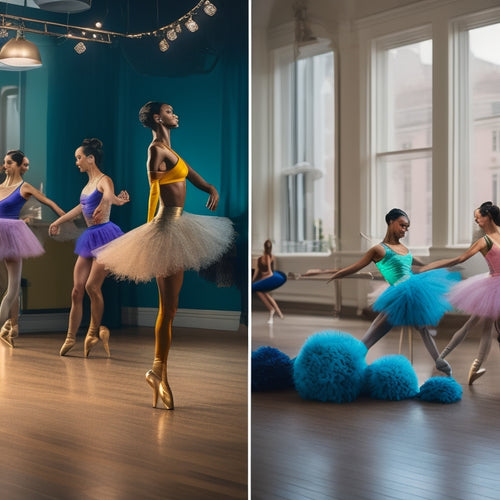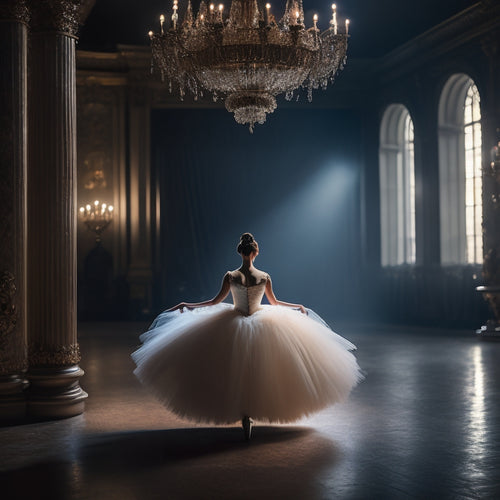
Does Pointe Ruin Your Feet?
Share
You put your feet through intense physical demands every time you dance en pointe, and it's no secret that this repetitive strain can take a devastating toll on your overall foot health. Chronic pain, deformities, and discomfort are all risks associated with pointe work. You'll need to maintain proper alignment, strength, and control to prevent injuries, and even then, issues can arise. From toe deformities to chronic pain, the long-term effects can be severe. But, with the right preventative measures and care, you can take control of your foot health and mitigate the risks – and there's more to learn about how to do just that.
Key Takeaways
• Pointe work requires precise alignment, strength, and control, which can lead to strain and injury if not executed correctly.
• Common foot injuries in dancers include toe and ankle strains, bunions, and hammertoes, often caused by repetitive stress and poor shoe fit.
• One in five dancers may experience toe deformities due to pressure, which can lead to chronic pain and discomfort if left untreated.
• Daily foot maintenance, proper technique, and preventative measures are crucial for mitigating the negative effects of pointe work on foot health.
• Long-term pointe work can lead to chronic pain, deformities, and mental fatigue, making proactive measures essential for career longevity and overall well-being.
The Physical Demands of Pointe
Dancing en pointe requires an extraordinary combination of strength, control, and precision. You must maintain proper alignment, turnout, and weight distribution while balancing on the tips of your toes. To achieve this, you need strong core muscles to support your body's alignment and stability.
Your core strength is vital in maintaining the correct posture, which in turn enables you to distribute your weight evenly on your toes. As you rise onto pointe, your body alignment is put to the test, and even the slightest deviation can throw you off balance.
Common Foot Injuries in Dancers
As you begin to explore the world of pointe, you'll quickly realize that toe and ankle strains are a common complaint among dancers.
You're also likely to encounter bunions and hammertoes, which can cause painful pressure and discomfort in your toes.
These injuries can be debilitating, but understanding their causes and symptoms is the first step in taking preventative measures to protect your feet.
Toe and Ankle Strains
You're likely to experience toe and ankle strains, common foot injuries in dancers, due to the repetitive stress and pressure from pointe shoes. The constant pressure and friction can lead to inflammation and pain in your toes and ankles.
Here are some reasons why you may be more prone to toe and ankle strains:
- Limited toe flexibility can increase the pressure on your toes, leading to strain.
- Poor ankle mobility can put additional stress on your ankles, causing strain.
- Overpronation or supination can cause uneven distribution of weight, leading to strain.
- Wearing pointe shoes that are too small or don't fit properly can exacerbate the issue.
It's essential to prioritize proper fitting pointe shoes, maintain good foot hygiene, and engage in exercises that improve toe flexibility and ankle mobility to reduce the risk of toe and ankle strains.
Bunions and Hammertoes
Proper shoe selection is crucial in order to mitigate the risk of developing bunions and hammertoes from the constant pressure and friction of pointe shoes. Ill-fitting shoes can worsen the problem, so finding a shoe that fits comfortably and provides adequate support is vital.
Prioritizing shoe selection as a dancer can help reduce the pressure on your toes and minimize the risk of painful deformities. By selecting the right shoes and being mindful of your foot health, you can dance freely and without pain.
The Impact on Toe Health
One in five pointe dancers will experience toe deformities, such as hammertoes or claw toes, due to the constant pressure and friction on their toes. As you dance en pointe, your toes are subjected to immense pressure, leading to potential deformities.
Here are 4 ways pointe can impact your toe health:
-
Toe Anatomy: The constant pressure can lead to bone deformities, affecting your toe anatomy.
-
Toe Aesthetics: Deformities can alter the appearance of your toes, affecting your self-confidence.
-
Pain and Discomfort: Toe deformities can cause pain and discomfort, making it difficult to dance.
- Long-term Damage: If left untreated, toe deformities can lead to long-term damage and chronic pain.
As you continue to dance en pointe, it's essential to be aware of the potential risks and take preventative measures to protect your toe health.
Foot Care for Pointe Dancers
As a pointe dancer, you know that daily foot maintenance is essential to prevent common injuries and keep your feet in top condition.
You should prioritize tasks like washing and drying your feet thoroughly, especially between the toes, and trimming your toenails straight across to prevent ingrown toenails.
Daily Foot Maintenance
You dedicate hours to perfecting your pliés and pirouettes, but neglecting daily foot maintenance can undermine your pointe work, so prioritize a consistent foot care routine to prevent injuries and optimize performance.
To keep your feet in top condition, incorporate the following habits into your daily routine:
-
Moisturizing routines: Apply a rich moisturizer to your feet, paying special attention to the heels and toes.
-
Exfoliation techniques: Gently exfoliate dead skin cells with a pumice stone or foot file, 2-3 times a week.
-
Clean and dry your feet thoroughly, especially between the toes.
- Trim your toenails straight across to prevent ingrown toenails.
Preventing Common Injuries
By prioritizing daily foot maintenance, you've taken the first step in preventing common injuries that can derail your pointe work.
Now, it's time to focus on proper technique to avoid further complications. Proper Alignment is vital when dancing en pointe, as it helps distribute the weight evenly and reduces pressure on your feet.
Safe Landings are also essential, as they help absorb the impact of jumps and prevent shockwaves from traveling up your legs.
By mastering these techniques, you'll reduce your risk of injuries, allowing you to dance with freedom and confidence.
Prevention and Treatment Options
Regularly incorporating preventative measures into your dance routine can greatly reduce the risk of developing pointe-related foot problems. You can take control of your foot health by integrating strengthening exercises, such as toe curls and heel raises, into your daily routine. Additionally, contemplate investing in footwear innovations, such as pointe shoes with cushioned insoles and arch support.
Here are some prevention and treatment options to ponder:
-
Strengthening Exercises: Integrate exercises that target your feet, ankles, and legs to enhance overall foot health.
-
Footwear Innovations: Invest in pointe shoes with advanced features, such as cushioning and arch support, to alleviate pressure on your feet.
-
Regular Breaks: Take regular breaks to rest and stretch your feet during long rehearsals or performances.
- Professional Care: Consult with a medical professional or dance therapist to address any foot issues before they become severe.
Long-Term Effects of Pointe Work
As you continue to dance en pointe, the repeated strain on your feet can lead to long-term effects that may impede your overall performance and quality of life. Chronic pain, inflammation, and deformities can become a harsh reality, forcing you to reevaluate your career longevity.
The mental fatigue that comes with constant pain can be debilitating, affecting not only your dance performance but also your overall well-being. It's essential to acknowledge that the long-term effects of pointe work can be detrimental to your freedom to dance without pain.
Understanding these risks can help you take proactive measures to mitigate the damage, ensuring a longer, healthier career. By prioritizing your foot health, you can reduce the risk of long-term effects and maintain the freedom to dance with joy and passion.
A Future Without Foot Pain
You can take control of your foot health and pave the way for a future without debilitating pain. By adopting mindful movement and healthy habits, you can break free from the cycle of discomfort and injury.
Here are some key strategies to get you started:
-
Strengthen your ankles: Weak ankles can lead to poor alignment and increased pressure on your feet.
-
Choose the right shoes: Select shoes that fit comfortably and provide adequate support for your feet.
-
Practice proper alignment: Make adjustments to your posture and alignment to reduce pressure on your feet.
- Take regular breaks: Give your feet a break and take regular rests to avoid fatigue and strain.
Frequently Asked Questions
Can I Wear Pointe Shoes With Orthotics or Arch Supports?
"Ha! You think pointe shoes are tough on your feet? Wait till you try stuffing orthotics in there too! But seriously, yes, you can wear customized insoles or supportive inserts with pointe shoes, but only if they're specifically designed for dance."
Do I Need to Have Perfect Feet to Start Pointe Work?
You don't need perfect feet to start pointe work, but understanding your foot anatomy and flexibility is essential; assess your arch type, toe length, and ankle mobility to determine your readiness for pointe shoes.
How Often Should I Get My Pointe Shoes Fitted?
You'll want to get your pointe shoes fitted every 2-3 months, as your feet adapt and grow, to maintain proper fit and prevent discomfort, ensuring peak performance and extending shoe longevity, following a regular fitting schedule.
Can I Dance En Pointe if I Have Bunions or Hammertoes?
You're wondering if bunions or hammertoes will hold you back from dancing en pointe. While it's possible, consider your foot anatomy and toe alignment; misaligned toes can exacerbate issues, so it's crucial to assess your individual situation carefully.
Are There Pointe Shoes Designed for Dancers With High Arches?
You'll be pleased to know that yes, there are pointe shoes designed specifically for dancers with high arches, offering high arch support and arch-friendly designs that cater to your unique foot shape, providing comfort and freedom to move.
Related Posts
-

Best Dance Footwear for Comfort and Performance
When selecting the best dance footwear for comfort and performance, prioritize shoes with exceptional arch support an...
-

Moo! Unveiling Latin Dance Culture Sensation
Latin dance culture is a vibrant phenomenon that embodies the essence of identity, community, and self-expression, re...
-

Unveiling Ballet: Insider Insights on Dance World
Ballet, an art form esteemed for its elegance and beauty, conceals a world of rigorous dedication, meticulous plannin...


